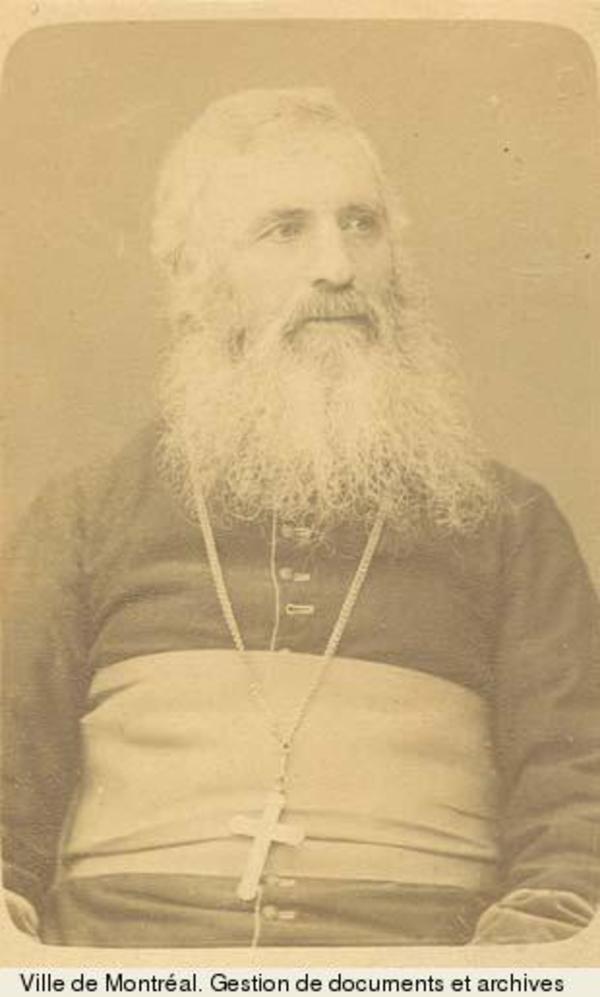
Source: Link
CLUT (Clew), ISIDORE, Roman Catholic priest, Oblate of Mary Immaculate, and bishop; b. 4 Feb. 1832 in Saint-Rambert-d’Albon, France, son of Nicolas Cleu and Élizabeth Guillermet, farmers; d. 9 July 1903 at Saint-Bernard mission (Grouard Mission, Alta).
Isidore Clut entered the Oblate noviciate at Notre-Dame-de-l’Osier, France, on 7 Dec. 1853 and, after taking his vows a year later, studied theology at Montolivet. He came to North America in 1857 at the invitation of Bishop Alexandre-Antonin Taché* of St Boniface. Taché ordained him priest on 20 December of that year and sent him to La Nativité mission at Fort Chipewyan (Alta). Clut served there from 1858 to 1869, also ministering to the Chipewyan called Caribou Eaters at the eastern end of Lake Athabasca. His life was filled with arduous journeys.
Burdened with poor health, Bishop Henri Faraud* of the Athabasca-Mackenzie vicariate, in which Clut was stationed, received papal permission in 1864 to select and consecrate his own auxiliary bishop. He chose Clut and, on 15 Aug. 1867 at La Nativité mission, consecrated him bishop of the titular see of Arindela. Because of a technical flaw in the ceremony – Faraud was assisted by only two priests rather than the two bishops called for by canon law – Clut never felt sure that his episcopal powers were canonically valid, and many of his colleagues doubted them too. The uncertainty severely affected his authority as administrator of the vicariate.
Clut attended the first Vatican Council in 1869–70. Thereafter he was stationed at Providence mission (Fort Providence, N.W.T.) to oversee the scattered missions of the vicariate, which numbered about 16 and extended almost to the Arctic Circle. In 1872–73 he visited Alaska, hoping to forestall Anglican missionary William Carpenter Bompas, who was evangelizing the north for his church. Faraud was dismayed at Clut’s initiative and the Oblates’ general council in Paris reprimanded him. With neither enough money nor sufficient clergy, the vicariate could not afford new ventures. In 1874, however, Clut took it upon himself to begin a school at Fort Chipewyan, and to do so he removed from Providence mission two of the Sisters of Charity of the Hôpital Général of Montreal who were teaching there. Indeed, his episcopal career was marked by independent decisions for which he was rebuked and by indecision which also raised the ire of his superiors and confrères.
In his later years Clut suffered from oedema in his leg and perhaps from diabetes. During the early 1880s he spent some years in France, seeking a cure while at the same time lobbying for increased support for his vicariate. In 1885–86 he became severely ill at Fort Good Hope (N.W.T.) and went to Montreal for treatment in August 1886. He travelled to France for medical help in 1887 and again in 1889. In the summer of 1890 he returned to the north. When Émile-Jean-Baptiste-Marie Grouard succeeded Faraud in charge of the Athabasca-Mackenzie vicariate in 1891, Clut stayed on as auxiliary and continued to visit the missions when his health permitted. In 1894, no longer able to sustain this rigorous life, he became chaplain to the Sisters of Charity of Providence at Saint-Bernard mission, where he remained until his death.
Over his lifetime Bishop Clut had assisted many missionaries in their study of native languages, and he was responsible for part of Emile Petitot*’s polyglot dictionary. His knowledge of the north was called on in 1888 when he testified before the Senate inquiry into the resources of the “greater Mackenzie basin.” The description he gave of the economy, the people, and the missions is a valuable record of the northern way of life a century ago. He had spent himself in the missions, travelling in winter and summer, preaching, teaching, and confirming, helping the priests of the vicariate, and enduring constant set-backs and difficulties. Yet his personality and the circumstances of his consecration as bishop meant that he was never as successful as had been expected early in his career.
A biography of Bishop Clut by a great-grand nephew, Claude Roche, Monseigneur du grand nord: Isidore Clut, évêque-missionnaire, coureur des bois, chez les Indiens et les Esquimaux du nord-ouest américain (de 1858 à 1903), was published in Paris in 1989.
Arch. of the Diocese of Mackenzie (Yellowknife), Clut à Faraud, 30 déc. 1871, 13 mai 1873, 12 févr. 1874, 18 févr. 1881, 19 août 1887; Délibérations du conseil général des oblats, 13 août 1874 (copie). Arch. Départementales, Drôme (Valence, France), État civil, Albon, 4 févr. 1832. Provincial Arch. of Alberta (Edmonton), Arch. of the Oblates of Mary Immaculate, Prov. of Alberta-Saskatchewan, 84.400, item 923 (V.-[J.] Grandin, copies des lettres à Clut, 1858–86). Can., Senate, Select committee to enquire into the resources of the great Mackenzie basin, Report (Ottawa, 1888), 135–43, 156–70. Canadian men and women of the time (Morgan; 1898). Gaston Carrière, Dictionnaire biographique des oblats de Marie-Immaculée au Canada (3v., Ottawa, 1976–79). Les Cloches de Saint-Boniface (Saint-Boniface, Man.), 1 (1902): 431–32; 2 (1903): 394–95. Le Jeune, Dictionnaire. “Nomination du père Isidore Clut, o.m.i.,” Oblate Life (Ottawa), 35 (1976), no.1: 51–78.
Martha McCarthy, “CLUT (Cleu), ISIDORE,” in Dictionary of Canadian Biography, vol. 13, University of Toronto/Université Laval, 2003–, accessed November 28, 2024, http://www.biographi.ca/en/bio/clut_isidore_13E.html.
The citation above shows the format for footnotes and endnotes according to the Chicago manual of style (16th edition). Information to be used in other citation formats:
| Permalink: | http://www.biographi.ca/en/bio/clut_isidore_13E.html |
| Author of Article: | Martha McCarthy |
| Title of Article: | CLUT (Cleu), ISIDORE |
| Publication Name: | Dictionary of Canadian Biography, vol. 13 |
| Publisher: | University of Toronto/Université Laval |
| Year of publication: | 1994 |
| Year of revision: | 1994 |
| Access Date: | November 28, 2024 |